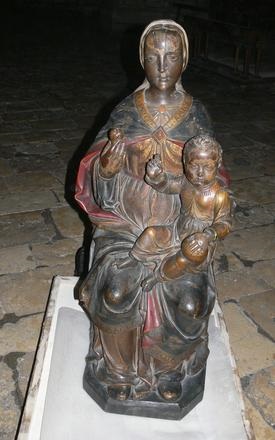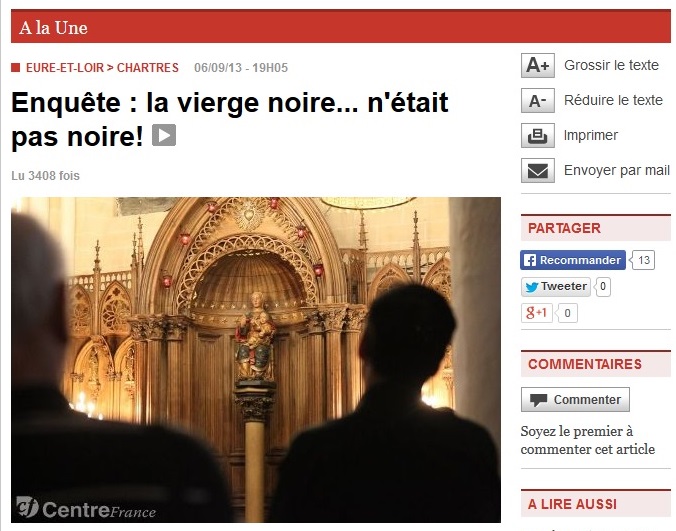[ Version en français : ]
Celui qui croyait au ciel
The man who believed in Heaven
Celui qui n'y croyait pas
The man who didn’t believe
Tous deux adoraient la belle
Both loved a beautiful woman
Prisonnière des soldats.
Held prisoner by the troops.
[...]
Quand les blés sont sous la grêle
When the wheat’s under a hailstorm
Fou qui fait le délicat
Only a fool gets picky
Fou qui songe à ses querelles
Only a fool thinks of past grudges
Au coeur du commun combat
In the midst of the common struggle.
Louis Aragon.
I]A century ago Marcel Proust, who knew a thing or two about snobbery, wrote:
![Chartres en danger [P. Werner]](/woid/woid21/woid21images/xxi13 Danger-Restoration.jpg)
What's striking today, when you get off the train at Chartres, is the large number of African French. Chartres, which a century back was properly appreciated by approaching the Cathedral on foot through fields of wheat while its spires rose above the plain, is now an extension of la grande banlieue, the outer edge of exile for immigrants and the underpaid.
And the Black Virgin is gone. Where it once stood, in the north transept of the Cathedral, now stands a rosy-pink Virgin with glow-red cheeks—the same statue restored, we are meant to believe, to its original state. The nave and choir, too, are being restored to their original state.
Except there is no original state. The earliest-known statue of a black Virgin at Chartres was destroyed in 1793, during the French Revolution. The present statue, the Virgin of the Pillar, dates from 1508; it was moved to replace the earlier one in 1796. This is the statue that was recently restored by the French State—the restoration of the architecture of the cathedral nave is still ongoing. Church property in France is the property of the state according to the law of 1905 that established a strict separation between the Catholic Church and the State. If, as the sociologists claim, the state maintains a monopoly on violence, then it's equally true that the French State maintains a monopoly on restorations, along with a tenuous monopoly on the construction of race and ethnicity, and a very firm monopoly on the destruction of cultures, of which the restoration of Chartres is a prime example.
 (720x524).jpg)
II]
There are perhaps as many as 500 statues of the Black Virgin throughout Europe. Many date back to the Romanesque or earlier. The meanings attached to their color are evolving constantly. Black may have once suggested the ancient chthonic forces from below: the first Black Virgin of Chartres was known as “Our Lady from Under the Ground.” A second attached meaning is that of the ancient, intuitive knowledge of peasants and pagans—the two words have similar roots. It’s a knowledge that’s thought to have preceded and anticipated Christian revelation, the knowledge of giants on whose shoulders we midgets stand, to quote Bernard of Chartres. This knowledge was paired with the obscure faith of the virtuous heathen, those lost in darkness with an intuitive knowledge of light—synaptic, you might say today. All of this formed a part of the Augustinian tradition of learning at the School of Chartres in the twelfth century. And now imagine little Marcel biting into a madeleine, realizing at that moment that knowledge shall be gained through the senses, and seeking that knowledge until the realization, some twenty-odd volumes later, that it’s the bodily experience of this knowledge that’s been gained in the process of describing it: the great lesson of Chartres Cathedral is the humility of knowledge in the face of intuition and personal experience.
Albrecht Dürer, who thought and painted hard about the accuracy of visual perceptions within the framework of divine inspiration, came to a similar humble reflection in his unpublished notes on the Theory of Proportions: “Black people's faces are rarely beautiful... Plus, their shinbones are too big.” His own inability to perceive the beauty in black people, he concluded, must lie in perception: the beauty of black people, like that of others, must lie not in their features but in the relationship of parts. Aesthetics, therefore, was not based on the intuitive observation of what is beautiful but on the observer’s own ability, God-given all the same, to intuit abstract relationships of parts.
From the sixteenth century on, the dark patina of bronze statues was associated with the universality of the Catholic faith: the reciprocal movement between blackness as skin color and blackness as a hinge-word around which a number of meanings were allowed to rotate, took on a greater social role. A large number of black saints and virgins appeared all over Latin America; even to this day, the Roma of France (who are dark-skinned enough compared to some other French people) pray to the image of Sara e Kali, “Black Sarah.” Dark patinas were also applied to wooden statues, as was done to the Virgin of the Pillar at Chartres, far more commonly known in Latin America as the Virgen del Pilar.
And then there is the African population of Chartres. There is a legend, in the seventeenth century, that an old woman in Sicily, on first seeing the Black Madonna of Tindari, shrieked, “What's the point of coming this far to see a woman as unattractive as I am?” Until the Virgin, by her miracles, persuaded her that those who seem unattractive to others may hide the greatest virtues. There must be some point to that, because until recently the Black Virgin of Chartres was a focal point for popular veneration, and secret offerings were left behind the statue. There is another legend I heard from the janitorial staff at Chartres, that a parishioner took her first look at the new, improved Virgin with her red checks and shrieked: “She looks as if she's been slapped!” The restorers haven’t erased the inscription from the collar of the statue reading: “Pulchra es,” “Thou art beautiful,” a quotation from the Song of Songs that directs the viewer back to another passage in the same book: “I am black but beautiful, O daughters of Jerusalem.”
III]
The restorers have chosen to ignore the passage, and the meaning, and the whole cultural background of the statue in favor of that usual fallback of reactionaries, the formal interpretation: according to the official statement of the French Ministry of Culture and Communications,
“Probably;” “unaesthetic;” “parti-pris:” curatorspeak for what the French call pifomètre, the schnozz as a measuring instrument. According to explanations provided by the one of the restorers there were two coats of polychrome paint on the statue’s vestments and only trace elements of carmine on the Virgin's face, hence the unsupported assumption that those few traces were the remnants of an original coat covering the whole of both faces and hands. Hence the decision to restore the image to the safer style of what was imagined to be a Renaissance aesthetic vision. Getting aesthetic in this instance meant following a post-Kantian fantasy about the overall coherence of a work of art that would have made a medieval viewer retch. For the blue eyes and blond hair of the Virgin and the Child there is no rationale, no scientific evidence, and no excuse: from the nineteenth century on the educational policy of the French Government was to teach all children of the Republic, black, yellow, white or brown, that “Our ancestors, the Gauls, had blond hair and blue eyes.” It's a fantasy that went the way of the colonies, at least as far as children go. The only incoherence the restorers have eliminated is the discrepancy they themselves must feel between the black faces and the heavenly robes: the unbearable whiteness of being.
IV]
ʼÓνος λύρας, as the Greeks would say: “The donkey plays the lyre.” At Chartres between the west and south portals there's a sculpture of a donkey playing a harp. The moral, as explained by the beggar singing by the door, is: “Don’t push beyond your competence, you’ll do nothing well,” adding: “As if the donkey cared.”
Proust did care that cathedrals be well used; cared so much that he took only two political positions in his lifetime, one for Alfred Dreyfus, the other against the law of 1905, the Law of Laïcité [Secularization] establishing the separation of church and state in France. Not that he supported the church—he had a Jewish mother, was sent to Sunday school as a child, and as an adult was a self-declared agnostic. Nor that he slavishly followed Ruskin’s concept of art as self-improvement, either, no matter what the Proust-will-change-your-life crowd might think—de Botton, thou art an ass! What mattered to Proust was that the separation would adversely affect the aesthetic experience of Chartres and the other great cathedrals:
Here Proust refers implicitly to article 28 of the 1905 law, which forbids the placement of religious signs on or in publicly owned buildings, with the exception of churches, museums, and galleries, as if all three were to be lumped in the same category. The state would tolerate religious objects and monuments as long as they could be safely relegated to the unchallenged realm of the Aesthetic. As one Catholic observer recently noted, “All that’s needed is to stick the word ‘exhibition’ in front of Baby Jesus, and the deed is done!” Ruskin, too, was happy to drain medieval art of its original Catholic content: “Cut missal up in evening—hard work,” he wrote in his journal. Unlike Ruskin Proust objected to an aesthetic that proposed to reduce (or, as it claimed, to elevate) the objects of aesthetic cognition to the level of the nonspecific—or, as it claimed, to the level of the universal and transcendent. This is why Proust can be placed alongside Freud, Bergson, the jurist Hans Kelsen, and others who undertook systematic critiques of that prevalent epistemology (rooted in Kant) according to which the subjectivity inherent in aesthetic (phenomenal) perception can only be transcended by knowledge (noumen) immanent to the perceiving subject.
Today post-Kantian Empiricism is the defining ideology of the state apparatus in France, a heady mixture of cant, Comte and con-job. This is the ideology that gives a police inspector the authority to discern the true meaning behind an eight-year-old's outburst over terrorism (Incitement to Step on Crack with Intent to Break Grandmother’s Back); that gives teachers the authority to determine when a scarf is a religious symbol or a sign that somebody’s just washed their hair; hence the arrogant response of the architect who oversaw the Chartres Project to an American scholar who had challenged the transcendent authority of the French state: [The Restoration of Chartres] “has the full weight of the administration of state, historians, and architects who decided over a twenty-year period what would be done.” The logical end-point of post-Kantian epistemology is that truth and the authority to speak are one. Somewhere, Michel Foucault is smiling.
V]
It’s been a long time coming. As Jonathan Israel argues, there is more than one form of the Enlightenment tradition to choose from. In the eighteenth century the French state chose the “moderate Enlightenment” of Voltaire, a curious mix of cultural relativism and moral absolutism, an attack against the Established Church (l’Infâme), in which the values of the state remain the authoritative ones, nec pluribus impar. Today, “Values of the Republic” is the code for whatever the state imposes by law; “Black is Beautiful” does not figure prominently among those values. Today the correct statethink is “secularism,” which means little except the right of the state to abolish all forms of communautarisme, which word in turn stands for all forms of ethnicity, race, or religion that the French State senses to be an existential threat, relentlessly playing one against the other, Jew against Muslim, secularist against Catholic, White against black. In Anglo-Saxon neo-liberal thought Communitarianism is the problem for which the Free Market is always the answer; in the French adaptation of state-directed capitalism, communautarisme is always the problem for which the state is the solution.
Today SSFO—the Secular State of France and the Occident— claims the authority to restore the nave of Chartres Cathedral to its “original“ state; but of course there is no original state, only the irrational, aesthetic imposition of one state or another as originary: the Nave-an-Sich. It’s a bit too early to say how bad the ultimate result will be because much of the nave is still covered in scaffolding, but in my personal, subjective but deeply pondered opinion, it sucks. The new sense of rigid pedantry is more in line with the repressive ideological regime imposed across Europe at the beginning of the thirteenth century, a regime that affected equally the doctrine of transubstantiation, the persecution of the Jews and the decoration of cathedrals: the letter killeth. Whether medieval or modernizing in intent, the use of solid planes of color flattens out spatial perception and renders invisible the shifting balance of light and shadows across the great columns of the crossing, the same play of movement felt by Proust in the shifting position of church spires across the countryside of Chartres as the viewer’s own position shifted in a perpetual interaction of the spatial and the temporal. It’s this view of the meaning of time that’s been desecrated at Chartres. Proust himself wrote that one must listen to the Cathedral. Listening to Chartres today is like hearing Debussy played on a penny whistle. There’s more than one Middle Ages; more than one history, and everyone is entitled to their own. No one has the right to destroy the history of others. To which Frantz Fanon would have added that the oppressor really doesn't care that the oppressed have a past: what counts is that they have no future.
VI]
As if the donkey cared. When asked what the parishioners might think of these restorations, the architect irresponsible responded, “I’m very democratic, but the public is not competent to judge.” That’s the only kind of democracy the Corporate State understands: the elites choose for the people in the name of the people; doing so they choose the people who are to be chosen, a subject for the object. However, the Church authorities at Chartres were consulted, and they, too, have chosen the proper people to pray before the Pink Lady: the local paper, appropriately called the Echo of the Republic, displays this breathtaking headline: “Results: the Black Virgin... wasn’t black!” along with a picture of the rosy red necks of the congregants. What a relief!
There is a process to protect historic monuments: UNESCO, the cultural arm of the United Nations, has classified Chartres as a World Heritage Site, a classification designed to encourage those responsible to preserve the site instead of mangling it to fit their cultural and racial biases. The designation also entitles the recipient to receive funding for preservation. The “restoration” of the Nave was funded by UNESCO and the European Union. The scraping of the Black Virgin was funded uniquely by the French Ministry of Culture. UNESCO funds are used all over the world for projects that divert cultural heritage from one class to another, as in Campeche, Mexico, for instance, where the colonial town has been gentrified and the locals told to move on.
Quis custodiet ipsos custodes?The overwhelming effect at Chartres is of a nineteenth-century provincial church full of affected austerity, une bondieuserie as the French would say. This is the medievalism of the Second Empire, when the State staged massive programs of bogus restoration along with aggressive encouragement of cultural programs that favored the entrenched values of the conservative churches of provincial France. This was, and is, the medievalism of the painter Hyppolite Flandrin, the faith of small-town bigots, the old alliance of Church reaction and State power: le sabre et le goupillon. Which happens to fit the interpretation of the Loi sur la laïcité now being quietly carried out by the Front National, the ultra-right political party that is gradually taking over the more benighted areas of Rural France:
Perhaps the UN should consider sending the blue helmets to protect the rest of France’s cultural heritage before it, too, is destroyed: the following quote comes from the website of the local branch of the Front National in Chartres (I’ve done my best to preserve the flavor of the original; the Front’s xenophobic agenda does not include the defense of French grammar and spelling):
We stand up for the quality of life that still has a chance to survive in our département, our traditions, our identity and be sure not to allow the euro-globalists to pursue their destruction of populations with roots.
…
Our local leadership is extremy [sic] attached to his land and identity that he knows perfectly.So against the infâme dictatorship of Euro-globalism, join us.
With no awareness of where he comes from and who he is: just as there is an originary Cathedral, there is an originary Frenchman; and that Frenchman alone is the one who knows. And acts.
Restoration and revolution have parallel roots: semantic, philosophic, and political. Both claim to return their subjects to an imaginary past that they’re in the process of making up. The destruction of Chartres Cathedral and all the culture it stands for has its counterpart in in the rising fascist revolution in France. Petite merde conchie grandes braies.
—PW
Deep Hanging : Claude GrunspanApril 1st 2015.
subscribe:
Like an RSS feed or Twitter, only easier: you drop me a note and every week or so I send you a short message with a link to my latest posting; other stuff, maybe every other month.donate:
Because paying no dues to Caesar is the one luxury that's not encouraged in a consumer society. Easy: you paypal me a buck or two.comments:
And you don't have to sign up to post them; they are moderated, though.

 (377x450).jpg)
.jpg)

